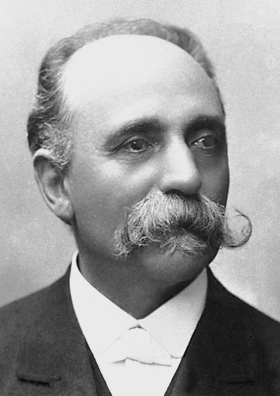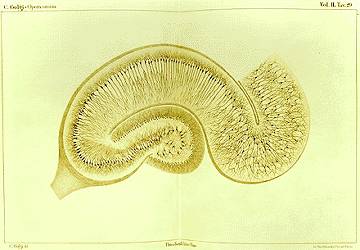
Camillo Golgi (1843-1926)
On July 7, 1843, Italian physician, pathologist, scientist, and Nobel laureate Camillo Golgi was born. His key discovery was the use of silver salts to stain samples for microscope slides. Thus new details of cellular structure components were revealed and several phenomena in anatomy and physiology are named for him, including the Golgi apparatus.
Camillo Golgi – Early Years
Camillo Golgi was born near Brescia in northern Italy. His father was a district medical officer. Golgi studied medicine at the University of Pavia under Giulio Bizzozero and Eusebio Oehl, and continued to work at the Hospital of St. Matteo in Pavia afterwards. It has been reported that Bizzozero had a great influence on Golgi in concerns of scientific research and especially in the fields of the nervous system, i.e. insanity, neurology and the lymphatics of the brain. At the Hospital for the Chronically Sick at Abbiategrasso, Golgi supposedly started his investigations into the nervous system in 1872. [1,2]
Academic Career
When Camillo Golgi returned to the University of Pavia as Chair for General Pathology in 1881, he succeeded his former teacher Bizzozero and married Bizzozero’s niece Donna Lina. During his time at the university, Golgi became an eager and liked teacher and it is said that his laboratory was always open to any student or scientist who wanted to work together or learn something. Golgi founded and directed the Istituto Sieroterapico-Vaccinogeno of the Province of Pavia and was Rector of Pavia University for a long time. During World War I, Golgi created a neuro-pathological and mechano-therapeutical centre for the study and treatment of peripheral nervous lesions and for the rehabilitation of the wounded. [1,2]
The Black Reaction
Camillo Golgi’s most famous achievement in science was probably his method of staining individual nerve and cell structures, which is referred to as the ‘black reaction‘. The xentral nervous system was difficult to study during Golgi’s time because the cells were hard to identify. The available tissue staining techniques were more or less useless for studying nervous tissue. While working as chief medical officer at the Hospital of the Chronically Ill, he experimented with metal impregnation of nervous tissue, using mainly silver (silver staining). In the early 1873, he discovered a method of staining nervous tissue that would stain a limited number of cells at random in their entirety. He first treated the tissue with potassium dichromate to harden it, and then with silver nitrate. Under microscope, the outline of the neuron became distinct from the surrounding tissue and cells. The silver chromate precipitate, as a reaction product, only selective stains some cellular components randomly, sparing other cell parts. The silver chromate particles create a stark black deposit on the soma (nerve cell body) as well as on the axon and all dendrites, providing an exceedingly clear and well-contrasted picture of neuron against a yellow background. This makes it easier to trace the structure of the nerve cells in the brain for the first time.[4] Since cells are selective stained in black, he called the process la reazione nera (“the black reaction”), but today it is called Golgi’s method or the Golgi stain.

Drawing by Camillo Golgi of a hippocampus stained with the silver nitrate method
The Golgi Appartatus
It is not clear however, when exactly Golgi made his discovery, but it is believed that he spent many years of his life modifying and improving the method. In 1898, Golgi also discovered and observed the Golgi Apparatus while investigating the nervous system. At first however, it is believed that Golgi doubted his discovery and argued that the structure was probably an optical illusion created by his observation technique. The term ‘Golgi Apparatus‘ first appeared in scientific literature in 1913. [1,3]
A Milestone in Cell Biology
Camillo Golgi’s discovery marked a milestone in cell biology, even though the existence of the apparatus was debated for many years. In the 1950s, it was finally confirmed with the use of electron-microscopes [2]. In 1906 Golgi shared the Nobel Prize with Santiago Ramón y Cajal for their studies on the structure of the nervous system.[4] Camillo Golgi died in January 1926 at age 82. His publications are collected in the Opera Omnia, which appeared in 1903 and 1929; the latter was edited by his co-workers. [2]
Lecture 4 Golgi Apparatus, [6]
References and Further Reading:
- [1] Camillo Golgi at the Nobel Prize Website
- [2] Life and Discoveries of Camillo Golgi by Marina Bentivoglio at the Nobel Prize Website
- [3] Camillo Golgi and “the Golgi”: one hundred years of terminological clones
- [4] Santiago Ramón y Cajal and the Microscopic Structure of the Brain, SciHi blog
- [5] Camillo Golgi at Wikidata
- [6] Lecture 4 Golgi Apparatus, Biotechnology Online @ youtube
- [7] Mazzarello, Paolo (2020). “Camillo Golgi: the conservative revolutionary”. Italian Journal of Anatomy and Embryology. 124 (3): 288–304
- [8] Marina Bentivoglio (20 April 1998). “Life and Discoveries of Camillo Golgi”. Nobelprize.org.
- [9] Mazzarello, P. (1998). “Camillo Golgi (1843–1926)”. Journal of Neurology, Neurosurgery & Psychiatry. 64 (2): 212.
- [10] Timeline for Camillo Golgi, via Wikidata






Pingback: Whewell’s Gazette: Year #2 Vol. #01 | Whewell's Ghost
Pingback: Whewell’s Gazette: Year 3, Vol. #47 | Whewell's Ghost